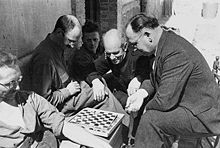Checkers

Checkers or draughts is the name of several different board games. All of these games are similar. In every kind of checkers, the other player's pieces can be taken by being "jumped" over.
"Checkers" is the American name. In British English, and in various other English-speaking nations, these games are called "draughts."
The rules and championships are controlled by the World Draughts Federation.
History
[change | change source]Checkers dates back certainly to the 12th century, in France.[1][2] These authorities do not admit that discoveries of earlier checkerboards prove the game was played earlier, though it may have been. Some other writers have thought differently, but they were not professional historians.[3]
There are two main types of checkers played: the Anglo-American version (which originally came from France) and the Polish or continental version. The Anglo-American version is played on an 8x8 checkerboard (chessboard) with 12 pieces. The continental version (so-called because it is played on the continent of Europe) is played on a 10x10 board with 20 pieces each. There are also a number of variations in various countries.
Rules
[change | change source]
In most games of checkers, there are two players. The players are at opposite ends of the board. One player has dark pieces, and one player has light pieces. They take turns moving their pieces. Players move their pieces diagonally from one square to another square. When a player jumps over their opponent's (the other player's) piece, you take that piece from the board. If you can take a piece, then you must take a piece.
English draughts
[change | change source]British people call the game "draughts". English draughts is played on an 8x8 chess board. Only the dark squares are used: the light squares are never used.
- Pieces. The pieces are flat and round. They are referred to as "men". They may be colored dark and light or red and white. The two sides are called Black and White.[2] Black has the first move. There are two kinds of pieces: plain (single) pieces and "double pieces". A double piece is made by putting one plain piece on top of another.
- Starting position. Each player starts with 12 pieces on the three rows closest to their own side. The row closest to each player is called the "Double Piece Row". The darker color moves first.
- How to move. all the single pieces (the starting pieces) can only move diagonally forward. They cannot move backwards.
A player can move in two ways. A piece can be moved forward, diagonally, to the very next dark square. If one player's piece, the other player's piece, and an empty square are lined up, then the first player must "jump" the other player's piece. The first player jumps over the other player's piece onto the empty square and takes the other player's piece off the board. A player can also use one piece to make multiple jumps in any one single turn, provided each jump continues to lead immediately into the next jump and in a straight line. Sometimes a player may have the option or a choice of which opponent piece he must jump. In such cases, he may then choose which to jump. If you keep your hand on any piece when you're moving, you have the choice to put it back and move another piece.
- Double Pieces. If a player's piece moves into the double piece row on the other player's side, it becomes a double piece. It can move forwards and backwards. A double piece cannot move out of the double piece row until the next turn.
- How the game ends. The first player to lose all of his or her pieces. or to be put in a position where they cannot move, loses the game. If neither player can force a win, the game is a draw.[4]
References
[change | change source]- ↑ Murray H.J.R. 1951. A history of board games other than chess. Oxford University Press, p72. ISBN 0-19-827401-7
- ↑ 2.0 2.1 Bell R.C. 1979. Board and table games from many civilizations. Revised edition, two volumes in one, New York: Dover, p71.
- ↑ Strutt, Joseph 1801. The sports and pastimes of the people of England. London, p. 255.
- ↑ "Checkers rules". Darkfish website. Retrieved 22 November 2014.
Other websites
[change | change source]- World Draughts Federation
- World Mind Sports Games Archived 2018-12-21 at the Wayback Machine
